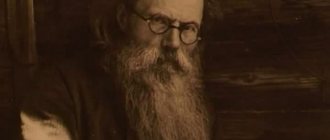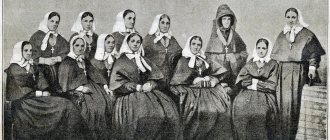LiveInternetLiveInternet
There are professions that will be in demand at any time. No robots can replace the warmth of human hands and the kindness of hearts, the kind word and light humor of a nurse who is on duty from morning to morning, administering IVs and giving injections, fulfilling all the doctor’s orders so that the patient is healthy. The first nurses in Russia nursed the wounded in the Crimean War (1853–1856). And the beginning of this profession was laid by Florence Nightingale (1820–1910). Her birthday, May 12, became the starting point of the International Nurses Day holiday. By this date we will talk about Russian sisters of mercy.
Before enlightening the reader about the Russian sisters of mercy, I will say a few words about the founder of the nursing movement, Florence Nightingale, who, being an aristocrat by birth, dedicated her life to alleviating the plight of the disadvantaged, developing humane principles for treating such patients.
Nightingale's method consisted of maintaining the strictest cleanliness in the wards, regular ventilation of the premises, proper diet, complete quarantine for contagious people and attentive attention to all complaints of patients. During the Crimean War, the Minister of War, having heard about the amazing sister of mercy, wrote her a letter asking her to help organize hospitals in the field. In the fall of 1854, Florence, along with 38 assistants, went to Turkey, and then to the Crimea to work in hospitals. As a result of properly organized care, in less than six months, mortality in hospitals decreased from 42 to 2.2%. The Crimean War made Florence a national heroine. Soldiers returning from the front told legends about her, calling her “the lady with the lamp,” because at night, with a lamp in her hands, she always, like a kind bright angel, walked around the wards with the sick.
In 1856, Florence, with her own money, erected a large white marble cross on a high mountain above Balaklava (near Sevastopol) in memory of the soldiers, doctors and nurses who died in the Crimean War. This woman is responsible for opening a school for training sisters of mercy, writing and publishing teaching aids, and reorganizing the army medical service. She paid great attention to hygiene issues not only of medical staff and patients, but also of all hospital premises, from wards to basements. It was she who ensured that medical institutions were equipped with ventilation and sewage systems, medical staff underwent the necessary “sterilization,” patients were strictly recorded, medical histories were drawn up, and all information was systematized.
Despite her serious illness (in 1856, the still young woman was confined to a wheelchair by a stroke), Florence actively put the principles of nursing ethics into practice. In 1872, she headed an expert commission on the sanitary condition of English military infirmaries and hospitals. In 1883, Nightingale was awarded the Royal Red Cross, and in 1907 she became the first British woman to be awarded the Order of Merit.
After the death of the great ascetic, the international organization of the Red Cross and Red Crescent (since November 1991 - the International Federation of Red Cross and Red Crescent Societies) established the Florence Nightingale Medal - the most honorable and highest award for sisters of mercy throughout the world. Since 1912, every two years on May 12, 50 medals are awarded to “the best of the best.” The medal is made of gilded silver, on the front side there is an inscription in Latin “In memory of Florence Nightingale. 1820–1910." In the center is an image of a woman with a lamp as a symbol of goodness, light, mercy and hope. On the reverse side of the medal it is written: “For true mercy and care for people, arousing the admiration of all mankind.”
In “Sevastopol Stories” L.N. Tolstoy mentions such sisters of mercy as Bakunina, Kartseva, Stakhovich, Khitrovo. In the hospitals of the Crimean War, 120 nuns of the Holy Cross Monastery cared for the wounded, 17 of whom died.
Ekaterina Mikhailovna Bakunina, a noblewoman by birth, like Florence, selflessly helped doctors in a Sevastopol hospital.
According to the memoirs of N.I. Pirogov, “every day and night one could find her in the operating room, assisting in operations, while bombs and missiles were falling all around. She displayed a presence of mind hardly compatible with female nature.”
. On behalf of Nikolai Ivanovich, Ekaterina Mikhailovna at the end of 1855 headed a new department of nurses for transporting the wounded to Perekop, and later she received an offer to head the Holy Cross community. After the Crimean campaign, Bakunina continued her medical exploits by opening a hospital in Novotorzhskrm district. She conducted receptions, visited the sick herself, provided medical care at her own expense, made bandages, gave medicines, made drugs herself, and paid the doctor’s allowance. She paid special attention to peasant children. She willingly accepted the duties of trustee of all zemstvo hospitals in the district, which were distinguished in the province in that they did not charge fees for medical care. During the Russian-Turkish War, the now middle-aged woman again worked tirelessly, sometimes sacrificing herself to the wounded in need of help and care.
Noblewoman Ekaterina Aleksandrovna Khitrovo became the abbess of the Holy Cross community of sisters of mercy, showing by personal example what is included in the range of professional responsibilities: not only to participate in operations, amputations, dressings, but also to monitor medicines, stop the theft of medicines and products, guard the belongings and money of the wounded .
In the list of sisters of mercy of the Crimean War, the name of Dasha of Sevastopol, whose father died at the Battle of Sinop, is immortalized. Without a medical education, Daria Lavrentievna Mikhailova independently organized a dressing station. Popular rumor dubbed it Sevastopol. Tsar Nicholas the First awarded Daria a gold medal “For Diligence.”
Princess Natalya Shakhovskaya with her daughters Nadezhda, Natalya and Vera, Ekaterina Novosiltseva, Praskovya Rosen, Princess Nadezhda Trubetskaya, Baroness Yulia Vrevskaya and others - this is an incomplete list of representatives of famous Russian dynasties who became sisters of mercy during the Russian-Turkish War.
On the left
is Baroness Yulia Vrevskaya,
on the top right is
Praskovya Rosen;
sisters of mercy during the Russian-Turkish War; below -
Princess Natalya Shakhovskaya,
bottom right -
tent hospital, set of tools
Among the aristocrats who helped the wounded on the fields of the First World War, Lyubov Dmitrievna Blok (née Mendeleeva), Empress Elizaveta Fedorovna, Empress Anna Feodorovna's closest maid of honor Anna Alexandrovna Vyrubova, noblewoman Elena Alexandrovna Dreyer.
Top left to right:
Elizaveta Fedorovna;
Empress Alexandra Feodorovna presents instruments during the operation. Princesses Olga and Tatiana stand behind. Princess V.I. is operating. Giedroyc. 4th from left Anna Vyrubova; bottom right:
Empress Alexandra Feodorovna treats a head wound.
1st and 3rd from left are Princesses Olga and Tatiana, 2nd from left are Anna Vyrubova, 4th from left are Princess V.I. Giedroyc; Anna Vyrubova in the courtyard of the palace hospital Author: Natalya Khanina
Who was the founder of the Sisters of Mercy Society?
Catherine Elizabeth Macauley is noted in encyclopedias as a servant of God, a Catholic nun. She was born on September 29, 1778. She was born into a wealthy family, in which besides her there were two more brothers. Love for one's neighbor and the basics of mercy were instilled in the girl by her father. He brought home children from low-income families every weekend and taught them the Catholic faith. However, when the girl was 5 years old, her father died, and her mother began to behave far from the spirit of a respectable Catholic. Naturally, this could not continue for long: the mother died in 1798. Then Katherine moved in with her uncle, who became her guardian.
However, even here everything went wrong: the uncle went bankrupt, and the girl was adopted by distant relatives, who were also not poor, having acquired property through trade with India. And in 1822, the girl received all this fortune at her own disposal. It was this money that Katherine decided to use for the benefit of the disadvantaged. Her first decision was to build a home for poor girls, single mothers and those elderly people who were abandoned to their fate. The House of Mercy assumed that people who needed both care and education would come here. This house was built on September 24, 1827. There were no believing women in the community, only secular ladies, and this became a reason for discontent on the part of the church. Katherine was required to give more Christian direction to the movement. This ultimately became the impetus for the founding of the Sisters of Mercy Society.
“Miracles are at every step.” Sister of mercy about her work and faith in people Read more
Despite the fact that Catherine was at the head of the new community for only about 10 years (the woman died in 1841), during this time she managed to organize 12 monastic societies in Ireland and a couple of the same communities in England. At that time there were 150 members. For comparison: in the early 2000s, the Sisters of Charity had 10,000 members. After the death of the founder of the community, her followers continued the tradition and began to organize new societies around the world.
Activities of the Sisters of Mercy
There are many versions regarding the work and organization of societies such as the Sisters of Mercy. For example, it is believed that the term “Sisters of Mercy” appeared in the 17th century. But it is more often mentioned that in the 17th century they spoke about the “Daughters of Charity”.
Today, this is the name given to those women from the communities who provide assistance as nurses in various situations and as volunteers when necessary.
"Saint Rimma" How a fragile sister of mercy raised soldiers to attack Read more
What is not prohibited is permitted
For example, the need to feed the homeless quickly emerged.
Our compound is located close to the Belorussky railway station, where groups of homeless people are concentrated. They regularly came to the courtyard to beg, and they were given food in cans. But the courtyard is not only close to the station, it is located on Tverskaya Street, surrounded by elite residential buildings and offices. Very soon the residents began to object, and something had to be decided. It was not possible to set up a canteen for the homeless on the territory of the farmstead, so we decided to organize a mobile canteen, took an old Gazelle and began to go to the homeless with hot food. But before, we spent a long time going through the authorities for permission to operate. The municipality and council verbally approved of us, but all requests to sign the required letter were refused under various pretexts. The crisis of 1998 broke out. There is no doubt left that our help to the homeless is necessary.
We knew that at Paveletsky station there was a similar bus from Protestants. Our sister went there on reconnaissance to find out what permits these guys had. Having learned that they did not have any permissions and did not ask for them, we ended our “walking through the authorities.” At the monastery we were given a small kitchen of six square meters, where we began to prepare porridge with meat, fish and vegetable additives, and brew tea. Everything that is donated to us is used. The sisters go to obedience at 10 am. By 13:00 they load the pots of food into the car and hit the road.
It was very difficult to choose a location so as not to disturb residents and institutions in the densely built Center. The police chased us around with machine guns to harrass us, they dragged us to the police department on the grounds that we were gathering a “contingent” that was in all respects undesirable in the capital, but then everyone was released. We don’t bring these people to the capital; they come here on their own. To the menacing question of the head of the 10th department of Tverskoy: “Who gave you permission?”, I answered simply. "It is forbidden? No? And what is not prohibited is permitted. We don't trade. And in our country, any citizen can go out and feed a person who needs it, and he does not need permission to do this.” Over time, we decided on a place in the right-of-way along the railroad, and they left us alone.
Since 1998, we have been consistently providing hot meals twice a week, and three times on holidays. We usually feed from 50 to 150 people. In summer it is less, because this contingent migrates like migratory birds. Our menu is stable. And we cook as if for ourselves. We distribute food in disposable dishes, which are also donated to us. There is a problem with the disposal of dishes, which in a good way should be collected in special conveyors and sent to a landfill, where waste from infectious diseases hospitals is disposed of. But it is very difficult and expensive. We have established a strict order. At the feeding, there is an elder among the homeless, whom we warn not to leave anything behind. Otherwise, the strictest measures will be taken against all of us. Therefore, they clean everything up after themselves, and the site remains clean after us.
I want to share my positive experience. Our activities require transport and drivers. After a bad experience with hired drivers (we can’t pay much), the sisters had to drive themselves. Now we have 12 sisters driving, and there is no problem with it. The sisters provide all trips around Moscow and the region on their own.











